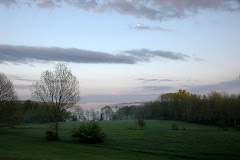Well, I have just returned from the National Preservation Conference, held in the Twin Cities of Saint Paul and Minneapolis this year. In my other life, the gainfully employed part, I work in the Conference Office at the National Trust for Historic Preservation, so you could say that this conference is our baby, beginning to end. All in all I think that this was a great event, to be honest I only have last year's conference held in Pittsburgh, PA to compare it to, but I would like to think that we can build on each year, getting better and better on many fronts. I am particularly proud of the moves we have made toward becoming green minded at the conference. We are moving toward having handouts and PDFs available online; our bags this year are recyclable; proposal submission and registration are done primarily online; and we have been working with our vendors to make sure they are following green practices when possible. In addition, leftover conference bags have made their way to Ghana via an international aid organisation. Watch this space as we apply lessons learned to the conference next year in Tulsa!
This year in the Twin Cities we had a particularly strong Green and Sustainable Track as well as a really good Rural Heritage Track. I will elaborate about my favorite Green and Sustainable education sessions. For more information about the Rural Heritage Track and the rest of the conference please visit http://www.nthpconference.org/
Matt Nowakowski, of the Air National Guard, pulled together a superb education session, Bringing the Past into the Future: Connecting the Preservation and Green Building Movements, featuring Joan Goody of Goody Clancy, Boston; Walter Sedovic of Walter Sedovic Architects, Irvington, NY; and Bill Dupont formerly with the National Trust and now with the University of Texas, San Antonio. Each of these three presenters highlighted different types of preservation projects that incorporated a variety of sustainable practices, some with LEED certification and others without. I think it is important to note that although LEED (and by extension USGBC) is seen as the leader in the certification field it is by no means the end all, be all. I will address this more in a another post.
Barbara Campagna, Graham Gund Architect here at the Trust also put together a very good education session, The Greenest Building is One that has Already been Built. Carl Elefante, of Quinn Evans, Washington DC and Mike Jackson with the Illinois Historic Preservation Agency, Springfield, IL demonstrated through their presentations that communities need to look to their existing building stock for ways to stem the tide of cultural losses and environmental degradation. They called into question not only the built resources that are being lost but also the embodied energy that goes when the buildings go. There is more research to be done in order to effectively make the environmental case for historic preservation, however, Carl and Mike are among those that have provided an excellent stepping stone.
Thursday, October 11, 2007
Subscribe to:
Posts (Atom)


